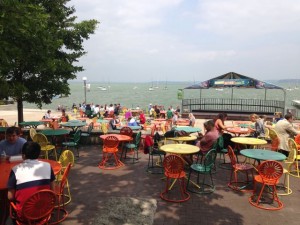I am a conference newbie, so selecting sessions to attend is complicated by not fully understanding the different options. Keynotes and workshops – I get those, but fireside chat, paper and poster sessions? not so much. Before I go any further I’ve got to comment on the food provided at GLS11. It is not your average proD fare. In fact, I think the brats and pretzels of lunch one on Tuesday was just a teaser because meals just keep getting more and more varied and complex. Of course, it never runs out so can eat your fill.
The morning breakfast keynote featured Dr. Nichole Pinkard and her Chicago Learning Network. Her goal is to integrate the learning of digital literacies between school, home and the community throughout the city with a system of completion badges. Mentors are used as the “secret sauce” to help students transfer their understandings and skills between the different settings of their lives so to maximize employment and educational opportunities for them where that otherwise may not occur. It is powerful and important work. Have a look at digitalyouthnetwork.org.
My next session was a presentation with breakout sessions based on a new publication: Teacher Pioneers: Adventures with Media, Pedagogy and Play in K-16 Learning. This resource is just becoming available and features a cast of impressive educators who tell their stories about innovation and change using playful learning. Sean Dikkers was the draw for me. I’ve heard him speak a few times now and he always captures my attention and interest. He was a principal in norther Minnesota in a school with a 100% drop-out rate for special needs learners. He was given carte-blanche to make any changes he saw necessary, so he introduced pedagogy of fun, play and gaming into all courses in the school. In a few short years 70% of the special needs students were now graduating.
Next up – UBC’s own David Ng, a geneticist and science literary writer with the Michael Smith laboratories, who spoke about how he has integrated a card-based game with his students and the impact that bringing the notion of play continues to have on them. David is a very interesting guy. Among other things, his dad beat-up Bruce Lee, which grants him cross-generational cred. I’ll be checking-out his joint session on collaborative content generation this afternoon.
One of the concepts that came out of this session was new to me- the proD “hack-a-thon”. Here, staff are challenged to create a digital tool or game for learning in a tight time period – typically 3 hours. It is high energy and crazy-making, and inevitably groups fail at some level (or many). In the process, they get to reframe failure as iteration of design rather than dishonour.
The fireside chat features the iconic Jim Gee, author of the ground-breaking book in 2003, What Video Games Have to Teach Us About Literacy and Learning. Jim sat in an armchair on the stage of the great hall in front of a 14-foot screen of a burning fire place (it was very funny), entertaining us all with his rant on assessment, appropriately called “Assessment and Stupidity.” I think the title speaks for itself. Jim was on fire (heh heh, sorry – could’t resist).
The afternoon was paper session time for me. This is where people are given 20 minutes to describe recent work that they have published. The theme of this sessions was reluctant learners. Betsy DiSalvo of the Georgia Tech presented her research on bad game design’s impact on the subject in Pink Boxes and Chocolate-Dipped Broccoli. It focused particularly on girls. Beth King of UW Whitewater presented a powerful paper on the challenges of African-American boys learning in gang-riddled South Chicago. This was particularly moving in light of the 54 people killed there this past weekend, including a 7-year-old boy in gang related violence. She used the Sims as a means for the boys to communicate what it is like to be “living in the Life.” It was eye-opening.
My favourite part of the day was the poster sessions in the Great Hall at dinner. Here, you have the opportunity to speak one-on-one with presenters who stand if front of high-production posters and share their work. The amount of work you can see while walking around with dinner in hand was amazing. Examples included: connecting students with autism with peers through games, how games support formative assessment, using games and simulations in climate change science education using games to teach global connectedness. One of my favourites was the work of Concordia’s Tom Fennewald, who has developed a card game called Troubled Lands. Here, players learn about the complex decision making of government about the environment by casting players as one of three characters who must compete and cooperate to manage the limited land they access to. Tom is going to share his resources with me so that I can play the game with my classes next year.
Of course, the beer continued to flow, and following a performance by Deidra Kiai called Cofee- A Misunderstanding people, attendees played games in the arcade area until midnight. I had to turn-in early. I was exhausted.

